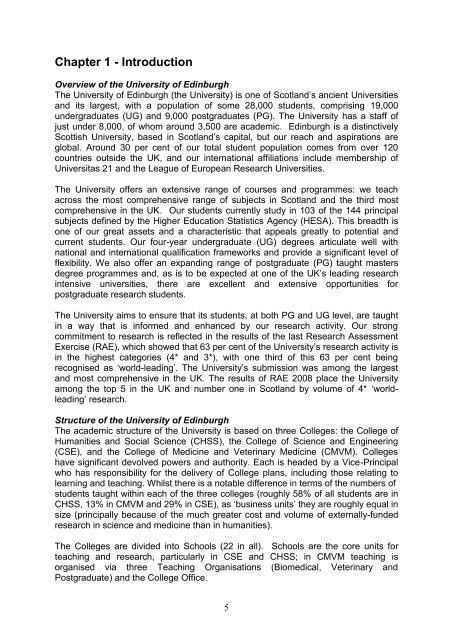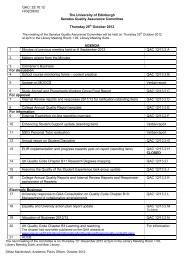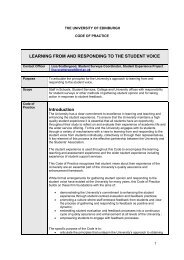Chapter 3 â Policy Implications for Gaelic - University of Edinburgh
Chapter 3 â Policy Implications for Gaelic - University of Edinburgh
Chapter 3 â Policy Implications for Gaelic - University of Edinburgh
Create successful ePaper yourself
Turn your PDF publications into a flip-book with our unique Google optimized e-Paper software.
<strong>Chapter</strong> 1 - Introduction<br />
Overview <strong>of</strong> the <strong>University</strong> <strong>of</strong> <strong>Edinburgh</strong><br />
The <strong>University</strong> <strong>of</strong> <strong>Edinburgh</strong> (the <strong>University</strong>) is one <strong>of</strong> Scotland’s ancient Universities<br />
and its largest, with a population <strong>of</strong> some 28,000 students, comprising 19,000<br />
undergraduates (UG) and 9,000 postgraduates (PG). The <strong>University</strong> has a staff <strong>of</strong><br />
just under 8,000, <strong>of</strong> whom around 3,500 are academic. <strong>Edinburgh</strong> is a distinctively<br />
Scottish <strong>University</strong>, based in Scotland’s capital, but our reach and aspirations are<br />
global. Around 30 per cent <strong>of</strong> our total student population comes from over 120<br />
countries outside the UK, and our international affiliations include membership <strong>of</strong><br />
Universitas 21 and the League <strong>of</strong> European Research Universities.<br />
The <strong>University</strong> <strong>of</strong>fers an extensive range <strong>of</strong> courses and programmes: we teach<br />
across the most comprehensive range <strong>of</strong> subjects in Scotland and the third most<br />
comprehensive in the UK. Our students currently study in 103 <strong>of</strong> the 144 principal<br />
subjects defined by the Higher Education Statistics Agency (HESA). This breadth is<br />
one <strong>of</strong> our great assets and a characteristic that appeals greatly to potential and<br />
current students. Our four-year undergraduate (UG) degrees articulate well with<br />
national and international qualification frameworks and provide a significant level <strong>of</strong><br />
flexibility. We also <strong>of</strong>fer an expanding range <strong>of</strong> postgraduate (PG) taught masters<br />
degree programmes and, as is to be expected at one <strong>of</strong> the UK’s leading research<br />
intensive universities, there are excellent and extensive opportunities <strong>for</strong><br />
postgraduate research students.<br />
The <strong>University</strong> aims to ensure that its students, at both PG and UG level, are taught<br />
in a way that is in<strong>for</strong>med and enhanced by our research activity. Our strong<br />
commitment to research is reflected in the results <strong>of</strong> the last Research Assessment<br />
Exercise (RAE), which showed that 63 per cent <strong>of</strong> the <strong>University</strong>’s research activity is<br />
in the highest categories (4* and 3*), with one third <strong>of</strong> this 63 per cent being<br />
recognised as ‘world-leading’. The <strong>University</strong>’s submission was among the largest<br />
and most comprehensive in the UK. The results <strong>of</strong> RAE 2008 place the <strong>University</strong><br />
among the top 5 in the UK and number one in Scotland by volume <strong>of</strong> 4* ‘worldleading’<br />
research.<br />
Structure <strong>of</strong> the <strong>University</strong> <strong>of</strong> <strong>Edinburgh</strong><br />
The academic structure <strong>of</strong> the <strong>University</strong> is based on three Colleges: the College <strong>of</strong><br />
Humanities and Social Science (CHSS), the College <strong>of</strong> Science and Engineering<br />
(CSE), and the College <strong>of</strong> Medicine and Veterinary Medicine (CMVM). Colleges<br />
have significant devolved powers and authority. Each is headed by a Vice-Principal<br />
who has responsibility <strong>for</strong> the delivery <strong>of</strong> College plans, including those relating to<br />
learning and teaching. Whilst there is a notable difference in terms <strong>of</strong> the numbers <strong>of</strong><br />
students taught within each <strong>of</strong> the three colleges (roughly 58% <strong>of</strong> all students are in<br />
CHSS, 13% in CMVM and 29% in CSE), as ‘business units’ they are roughly equal in<br />
size (principally because <strong>of</strong> the much greater cost and volume <strong>of</strong> externally-funded<br />
research in science and medicine than in humanities).<br />
The Colleges are divided into Schools (22 in all). Schools are the core units <strong>for</strong><br />
teaching and research, particularly in CSE and CHSS; in CMVM teaching is<br />
organised via three Teaching Organisations (Biomedical, Veterinary and<br />
Postgraduate) and the College Office.<br />
5






